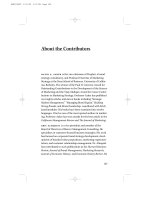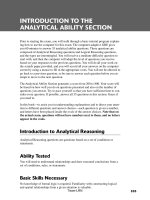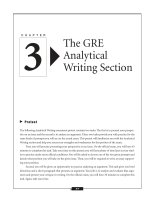About the Analytical Writing Assessment
Bạn đang xem bản rút gọn của tài liệu. Xem và tải ngay bản đầy đủ của tài liệu tại đây (88.95 KB, 10 trang )
The first part of the GMAT® exam is the Analytical Writing Assessment (AWA): a two-part essay exam
designed to measure your ability to think critically and convey your ideas effectively in writing. The AWA con-
sists of two separate writing questions: an Analysis of an Argument and an Analysis of an Issue.You will have
30 minutes to write each essay.
Analysis of an Issue
For the Analysis of an Issue essay, you will be presented with a short statement (one to three sentences) about
an issue, and you will be asked to take a position on the issue. Your essay should clearly state your opinion
and support that opinion with specific reasons and examples.
Issue Topics
The issue topics can be about anything, including business, social, political, or ethical matters. Whatever their
subject matter, issue topics will be general enough so that all test takers can form a reasonable opinion on the
issue. You will not need prior or specialized knowledge of the subject to write an effective essay. For example,
CHAPTER
About the
Analytical
Writing
Assessment
14
221
you do not need specific knowledge of how successful corporations work to answer the Analysis of an Issue
prompt from the pretest. Indeed, this prompt is a good example of how open AWA issue questions usually are.
Notice, for example, the number of terms that can be defined in many ways, leaving the prompt open to a wide
range of responses:
“Successful corporations have a moral responsibility to contribute to society by supporting education,
nonprofit services, or the arts.”
What makes a successful corporation? What sort of responsibility is needed? What kind of contribu-
tion must be made? What kind of support is required? This prompt can generate many different responses
depending upon the focus each writer chooses.
Here is a sampling of the kinds of general issues you might see on the AWA:
■
what schools should teach students (e.g., ethics versus academics)
■
the best methods for protecting the environment
■
the best way to motivate employees
■
the keys to success
■
the best way to improve employee-supervisor relations
■
the impact of technology, consumerism, globalism, mass media, or other predominant features of our
culture or times
■
the responsibilities of government, corporations, or individuals
■
the best preparation for the workforce
■
corporate policies, especially regarding employees, privacy, and the environment
■
healthcare
■
advances in science and technology, especially those that impact the workplace
Analyzing the Issue
The AWA is designed to measure both your writing and analytical skills. Thus, to receive a high score on this
essay, you must show evidence that you have carefully considered all sides of the issue and the pros and cons
of your position. As you plan your response, consider the following questions:
■
What positions can be taken on the issue?
■
What are the pros and cons of each major position?
This does not mean that a good Analysis of an Issue essay will explain each position and present all of
the pros and cons for each side; not enough time is available for such a comprehensive review. However, your
essay should do the following:
■
Acknowledge the other side, especially powerful counterarguments that might be made by the
opposition
■
Concede any serious drawbacks or flaws in your position
–
ABOUT THE ANALYTICAL WRITING ASSESSMENT
–
222
For example, the Analysis of an Issue essay in the pretest skillfully acknowledged the opposition and then
presented a rebuttal to that position:
Although some may argue that corporations have a responsibility only to their stakeholders and
their bottom line and do not legally have a responsibility to “do good” in society, they miss the
point that social responsibility is in the best interest of the company. Companies that actively par-
ticipate in social programs aimed at curbing crime, fighting poverty and illiteracy, and teaching
skills to those in need reap bottom-line benefits from their social programs every day. These pro-
grams not only have a positive impact on the local communities where they are enacted, but they
also continue to deliver dividends to the organization in positive public relations, building the
image of the company in the eyes of the community and developing a more effective employee
base.
Analysis of an Argument
For your Analysis of an Argument essay, you will be presented with a short argument (one paragraph that is
one to five sentences long).Your task will be to critique the reasoning behind that argument. In this essay, you
should not offer your opinion of the issue in the argument; instead, you must offer your assessment of the
argument by evaluating the logic (or lack thereof) of the claims.
Argument Topics
The argument in your writing prompt can also be about any topic, although a majority of the topics are some-
how related to business. Once again, you will not need to have any specific knowledge about that topic to
respond effectively in an essay. For example, the Analysis of an Argument prompt in the pretest is business
related, but you do not need to know anything about owning a restaurant to successfully critique the argu-
ment. You just need to be able to analyze the argument and present your analysis in an organized and engag-
ing manner.
The following is a sampling of the kinds of general subjects you might find in argument prompts on
the AWA:
■
strategies for improving business or services
■
which products or services to choose
■
how to spend funds or save money
■
health and environmental issues
■
societal trends
–
ABOUT THE ANALYTICAL WRITING ASSESSMENT
–
223
AWA Prompt List
Want to see the AWA writing prompts from last year’s GMAT exam? You can download a complete list of the
2001–2002 AWA essay prompts from the website www.mba.com/mba/TaketheGMAT/Tools/AWATopics2001.htm.
224
Analyzing the Argument
On the analysis level, your readers will be looking for evidence that you have considered the following
questions:
■
What assumptions underlie the argument? Are they reasonable or problematic? If they are problematic,
why?
■
What is the conclusion of the argument? Is it a logical conclusion based on the evidence?
■
Does the argument have any logical fallacies?
■
What evidence would help strengthen the argument?
■
Are there counterarguments or alternative explanations that would weaken the conclusion?
■
Is there any information that would help you better evaluate the conclusion?
Although the arguments on the AWA may be somewhat logical, they will usually have at least one sig-
nificant flaw that you will need to recognize. The argument may do the following:
■
be based on problematic assumptions
■
jump to conclusions
■
compare apples to oranges
■
ignore alternative explanations
■
show poor reasoning
The argument from the pretest, for example, was based on the problematic assumption that location is
everything and a move was therefore necessary to improve business. This ignored alternative explanations for
the lack of business, including the possibility that customers were simply dissatisfied with the food, price, or
service. It also did not consider other possibilities for attracting customers to the current location. Finally, it
neglected to consider the high cost of the move.
A solid grasp of critical reasoning skills is essential not only for the critical reasoning questions on the
Verbal section but also for an effective analysis of the argument on the AWA. To review critical reasoning skills,
see pages 87–107.
To earn a 4, 5, or 6 on the AWA, your essays will need to have the following six characteristics:
• A clear main idea (thesis). Do you have something to say? In the issue essay, have you taken a clear posi-
tion? In the argument essay, have you expressed your main assessment of the argument?
• Sufficient development. Have you explained your position or your judgment of the argument?
• Strong support. Have you supported your ideas with specific reasons and examples?
• Effective organization. Have you presented your ideas and support in a logical order?
• Clear, controlled sentences. Do your ideas come across clearly in properly constructed sentences?
• Grammatical correctness. Have you followed the conventions of standard written English?
Remember that this is an analytical writing assessment. An essay may be beautifully written, but if it doesn’t
show evidence of critical reasoning, it will not receive a top score.
What Makes a Good Essay?
225
How the Essays Are Scored
Two independent readers will score each AWA essay holistically on a scale of 0 (lowest) to 6 (highest). Read-
ers will take into consideration the overall effectiveness of each essay, including its content, style, and gram-
matical correctness. An essay that expresses sophisticated ideas in sentences full of errors will not receive a
top score, but that same essay can earn a 6 even if it has a couple of grammatical mistakes or an awkwardly
phrased sentence.
A holistic approach means that readers will be looking for the following elements:
■
the level of critical thinking evident in your ideas
■
effective organization
■
sufficient development of ideas
■
strong and sufficient support of ideas
■
effective word choice and sentence structure
■
clear and controlled sentences
■
a command of the conventions of standard written English
Your AWA score will be the average of all four scores, two for each essay. If two scores for one essay dif-
fer by more than one point, a third independent reader will rate your essay and all five scores will be aver-
aged for your total AWA score.
Getting to Know E-rater
®
As we noted in the first chapter, one of your readers will be a college or university faculty member specially
trained to review GMAT essays. The other reader, however, is likely to be a computer program called E-rater®,









